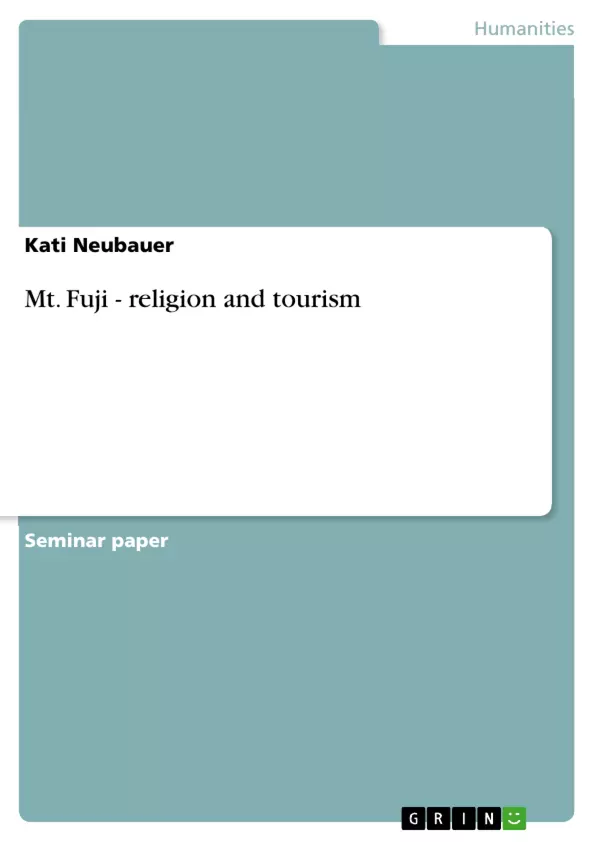Japan’s national symbol and most holy sight, Mount Fuji, has always been attractive to pilgrims. Over the years the motivation for a pilgrimage on Mt. Fuji has changed dramatically. From exclusive religious intentions the mountain is open today to sport climbers and tourists as well. This essay discusses how religion and tourism go hand-in-hand starting off from the past on to today’s Mt. Fuji, and argues that commerce and religion in fact are not as separate as one would think.
Inhaltsverzeichnis (Table of Contents)
- Introduction
- Religious worship
- Pilgrimage to Mt. Fuji
- The issue with females
- Foreigners on sacred ground
- New pilgrim groups
- Today's Fuji Industry
- Distraction caused by Mt. Fuji tourism
- Conclusion: Mt. Fuji- religion and commerce
Zielsetzung und Themenschwerpunkte (Objectives and Key Themes)
This essay aims to explore the intertwining relationship between religion and tourism in the context of Mount Fuji, tracing its evolution from a sacred site exclusively for religious purposes to a popular tourist destination. The essay will examine how religious practices and beliefs have adapted to the changing landscape of Mount Fuji and argue that commerce and religion are not as distinct as they may seem.
- The evolution of Mount Fuji from a sacred site to a tourist destination
- The historical significance of religious worship and pilgrimage to Mount Fuji
- The impact of gender and social exclusion on access to the mountain
- The role of the Japanese government and religious groups in shaping the image of Mount Fuji
- The interplay between religion and commerce in the context of Mount Fuji
Zusammenfassung der Kapitel (Chapter Summaries)
- Introduction: This chapter introduces the topic of Mount Fuji as a national symbol and holy sight in Japan, highlighting the changing motivations for pilgrimage over time. It discusses the historical restrictions on women and foreigners and the rise of the mountain as a tourist attraction.
- Religious worship: This chapter delves into the religious significance of Mount Fuji, highlighting its importance in Shinto and Buddhist beliefs. It discusses the reverence for mountain spirits, the practice of asceticism, and the establishment of shrines and temples on the mountain.
- Pilgrimage to Mt. Fuji: This chapter explores the history and practices of pilgrimage to Mount Fuji. It examines the development of organized pilgrimages, the use of inns and travel stations, and the emergence of religious groups dedicated to worshiping the mountain.
- The issue with females: This chapter discusses the historical exclusion of women from Mount Fuji, rooted in religious beliefs about purity and pollution. It explores the efforts of women to gain access to the mountain and the eventual opening of the summit to women in 1872.
- Foreigners on sacred ground: This chapter addresses the rise of nationalism in 19th-century Japan and the impact on access to Mount Fuji for foreigners. It details the first successful ascent of the mountain by a foreigner, Sir Rutherford Alcock, and the political tensions surrounding his journey.
Schlüsselwörter (Keywords)
Mount Fuji, religion, tourism, Shinto, Buddhism, pilgrimage, sacred site, gender, social exclusion, nationalism, commerce, Japan, cultural heritage, religious practices.
- Citar trabajo
- Kati Neubauer (Autor), 2008, Mt. Fuji - religion and tourism, Múnich, GRIN Verlag, https://www.grin.com/document/133133



